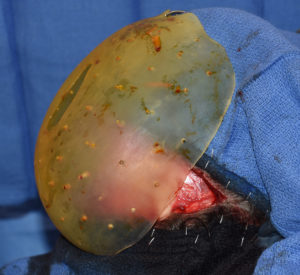
The implant is placed through a scalp incision as small as possible. Even such a large skull implant can be placed through an incision smaller than its width due to the implant’s flexibility.
How large a skull augmentation that can be accomplished is determined by the ability of the scalp to stretch. After the incision and undermining the scalp can stretch to cover an implant to varying degrees. Each person’s scalp has different amounts of elasticities which is partially related to how thick it is. The thicker the scalp the more it is capable of stretching in my experience. There is an unknown balance in each patient between how much their scalp can stretch vs how large can the skull implant be. This is carefully evaluated and thought through during the custom skull implant design process.
When it is believed that the amount of skull augmentation desired exceeds the ability of the scalp to stretch to accommodate it, a first stage scalp tissue expansion is needed. A small inflatable device is initially placed and expanded by percutaneous saline injections until the scalp has developed additional stretch. This is usually done six to eight weeks prior to the placement of the custom skull implant. This is needed in less than 10% of skull augmentations in my experience.
Dr. Barry Eppley
Indianapolis, Indiana


